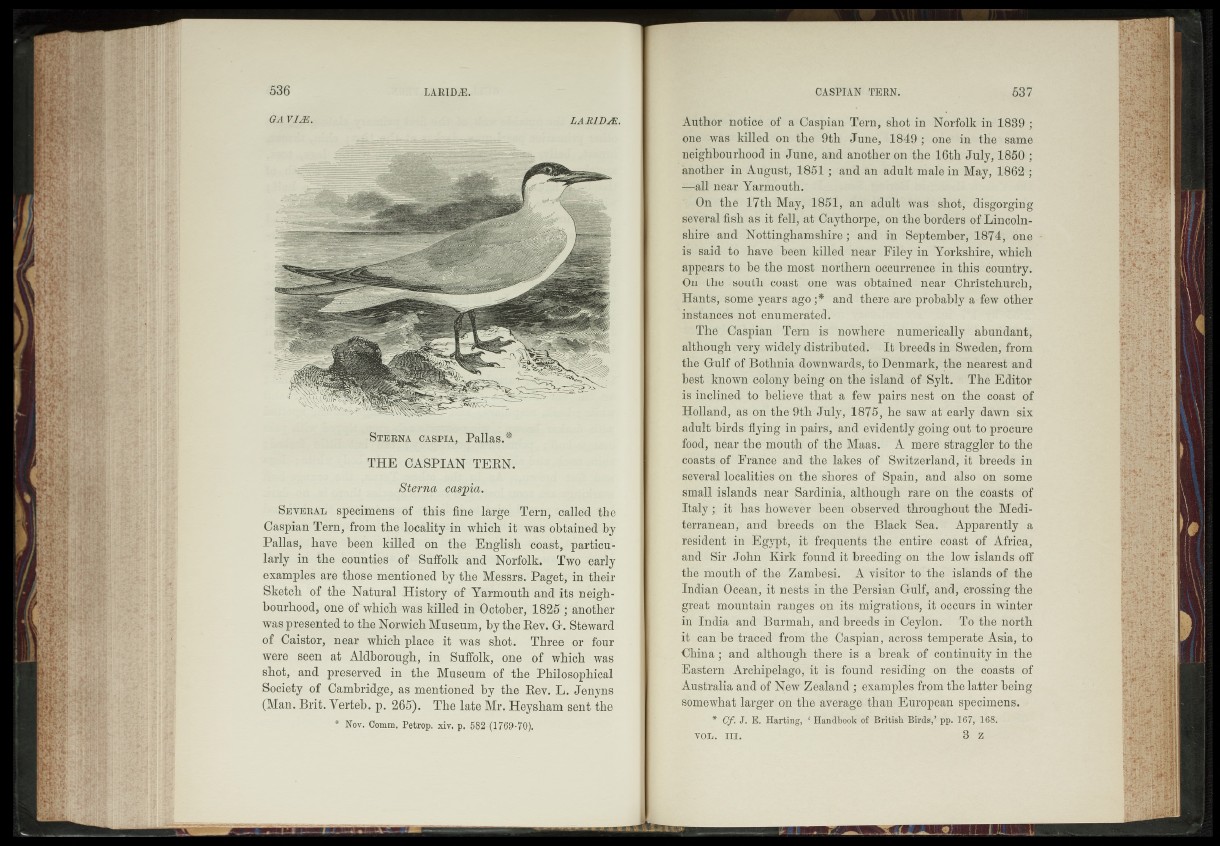
GA VIM. LARID JE.
S t e r n a ca s p ia , Pallas.*
THE CASPIAN TERl#*.
S te rn a easpia.
S ev e r a l specimens of this fine-large *Tern, Ccalle'd the
Caspian Tern, from the locality^ which it1*was ffftatffedTBy
Pallas, have >been killed on the »English coast, 'particularly
in the counties of -Suffolk and Norfolk. Two early
examples are those mentioned by -the Messrs. Paget, in'their
Sketch of the Natural History of -Yarmouth and its •IfUgh-
bourhood, one off which-was killed in Octobqr^g.825'| Another
was presented to the Norwich Museum, by the Rev. G. Steward
ef Caistor, near which place it was shot. Three pjy ffour
were seen at Aldborough, in^-Suffolk, one ef which hwas
shot, and preserved in the Museum of the Philosophical
Society of Cambridge, as mentioned,by the-RevrL. .Km tis
(Man. Brit. Yprteb. p. 2,65). - l The late Mr. Heysham sent the
* Nov. Oomm. Petrop, xiv. p. 582-('1709-7-0):* v
Author notice of a-Caspian Tern, shot in Norfolk in 1839;
one was killed on th e .9th June, 1849; one in the same
neighbourhood in June, and another on the 16th July, 1850 ;
another in August, 1851; and an adult male in May, 1862 ;
—all near Yarmouth/ .
1 On the 17th May, 1851, an adult was shot, disgorging
several fish as it fell, at Caythorpe,- on the borders of Lincoln^
shire and Nottinghamshire; and in September, 1874/Ane
is said t© § have been killed near Filey in Yorkshire, which
appears to beifhe most northern oCGurreheeJin this country;
On the -south coast’ one was obtainedI near Hhrisfchurch,
Hants, some years'ago *-* and there- are probably' a- few other
instances not) enumerated .-
'^tThe; Caspian Tern-" ’is' 'noWheïe numerically abundant;
although vety- widely distributed/ It -breeds :in -Sweden, f rom
the Gulf of Bothnia downwards^tO Denmark, the nèarest and
best known colony" beihglon the islanebofi'Syït. The Editor
«rpclined to4 bêliéve that a few pairs nest on the coast .of
Holland, as on the 9th Jnly,/&87‘5/:he£eaw-at early dawn six
aduiff birds. flying%i pairs, and evidently going out to.procure
food, near the mouth of^the Maas. W mere' straggler tóthe
cbasts. of" France and the lakes of- Switzerlandjlft breeds in
Several localities bh: thë "shores’ of -Spain, - and also:on some
small islands near Sardinia, although rare on the cqasts of
Italy ’has however' heem Observed throughout the Mediterranean/
and %reed#Fon the/Black''’ Se&v - Apparently,, a
resident in Egypt,' i.t frequents the entire, coast iff, Africa,
and Sir John Kirk found it breeding-on the low islands) off
the mouth of the Zambesi. A''visitor- to-the islands of the
Indian. Ocean, it nests in the Belgian: Gulf, and, crossing the
grêat mountain rangegllh its1 migrations, it occurs .'in, winter
in India and Burmah, and^brë'eds in Ceylon. Todthe.-north
nfcbamhe traced? ffrokt the Caspian/'abrbsSt temperate Asia, to
China; and afthbughibere? iS a break of1 continuity in the
Eastern Archipelago, ijt is-found residing -Mi the coasts, of
Australia and of NeW-'Zealand ; Examples from the latter being-
somewhat larger on the WêiagëLthan European specimens.-,;
* Cf: I. E. Hartfrjg/^ Handbook -.of Bri^etfElrdB/pp^-P67;-1 5 8 ? ^
Ë?iVol. in. E '3 ■ z